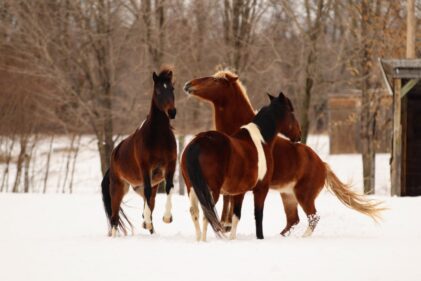By Kiley Komro
- For your horse(s)
- Your horse should be fit and able to handle whatever terrain you plan to tackle on your ride.
- Your horse should be well mannered outside of an arena and with other horses.
- You should bring well fitting tack.
- Saddle English or western whichever you choose, (I myself prefer western for trail riding as it is more supportive and you can strap many saddle bags to it to carry first aid supplies, lunch, and a rain coat should weather turn bad.) So long as it fits you and your horse.
- A clean saddle pad that covers about 1 inch outside of the saddle.
- A well fitting cinch and back cinch (if using a western saddle), or a girth.
- A bit that your horse is already comfortable with (a trail ride is not the best place to test out a new bit for Blackie, stick to the one he has used since you got him).
- A bridle or headstall (or halter – bridles) whatever you choose.
- A pair of reliable reins: they can be rope or leather, one piece or split. It doesn’t matter what kind so long as they are serviceable and sturdy. (But make sure you have an extra pair in case one breaks.)
- If riding extreme terrain bring a breast collar that fits snugly but make sure it doesn’t pinch (the last thing you want is a sore horse 15 minutes into your ride).
- If your saddle tends to shift forward you can think about adding a crupper to your trail-riding tack but it is not necessary.
- Your horse will be wearing a halter and lead rope while being trailered but always bring an extra of both in case of emergency.
- If riding rocky terrain or your horse is prone to sore feet you may want to have you farrier shoe him or get boots to protect his hooves.
- Groom’s box: a place to put all of your grooming tools to keep them clean and organized, not to mention portable. The following is what should be inside.
- Metal curry comb/shedding blade: usually shaped in a circle with a plastic handle – use lightly on dried mud, and more vigorously on a shedding coat.
- Rubber curry comb: circle or oval shaped, made of plyable rubber with rubber tines in several rows – rub in small circular strokes to lift dirt and dead hair and skin to the surface and to promote circulation.
- Stiff/dandy brush – use in swift “sweeping” strokes to whisk debris away from the coat and bring out the natural oils in the coat.
- Body brush: made with softer bristles than a stiff brush, sometimes made with horsehair – first use like a stiff brush to sweep smaller dirt particles away and then smoothly brush the coat to bring out the shine.
- Mane and tail brush: the best ones to use are similar or identical to hairbrushes for humans as they are gentle with the hair – brush as if you are brushing your own hair, start with smaller strands and work your way up and throughout.
- Hoofpick – find the easiest way to hold your horse’s hoof and pick the dirt and stones out.
- Fly Spray: a must have when riding in the spring and summer, make sure it is full before heading out. Spray only over the parts that are not covered by tack, use a clean cloth to wipe it on his face.
- First Aid Kit (human and equine). The following list will be separated into Human section and Equine section.
- Human
- 2 Absorbent compress dressings (5 x 9 inches)
- 25 adhesive bandages (assorted sizes)
- 1 adhesive cloth tape (10 yards x 1 inch)
- 5 antibiotic ointment packets (approx 1 gram
- 5 antiseptic wipe packets
- 2 packets of aspirin (81 mg each )
- 1 space blanket
- 1 instant cold compress
- 2 pair of nonlatex gloves (size large)
- 2 hydrocortazone ointment packets (approx 1 gram each)
- Scissors
- 1 Roller bandage (3 inches wide)
- 1 roller bandage (4 inches wide)
- 5 sterile gauze pads (3 x 3 inches)
- 5 sterile gauze pads (4 x 4 inches)
- 2 triangular bandages
- Thermometer (non mercury/nonglass)
- Tweezers
- First aid instruction booklet
- Horse: items can be sealed in zip closure bags to keep thing organized.
- Mercury or digital thermometer
- Here is a link with a horses normal pulse, respiration and heartbeat: http://horses.about.com/od/basiccare/qt/basictprs.htm
- Scissors (you can use the pair in you human kit)
- Clean polo/leg wraps for emergencies. (since you want them to be clean you should have a separate set from the non-emergency set)
- Absorbent padding to use under leg wraps or cut up for dressing
- Gamgee cloth
- Clean burping diapers
- Gauze diapers
- Leg cottons under stable wraps work as well. The cottons must be kept clean so seal in a zip closure bag
- Adhesive bandages
- Zinc oxide cream
- Epsom salts
- Equine first aid booklet
- Mercury or digital thermometer
- Human
- Buckets: can be used for all sorts of jobs
- Pitchfork or shovel: used to clean out trailer and anything you horse deposited in the day use area (trail head may or may not supply wheelbarrows).
Acknowledgements
Human first aid kit – Red Cross
Horse first aid kit – About.com horses
Now you are prepared to hit the trails!
